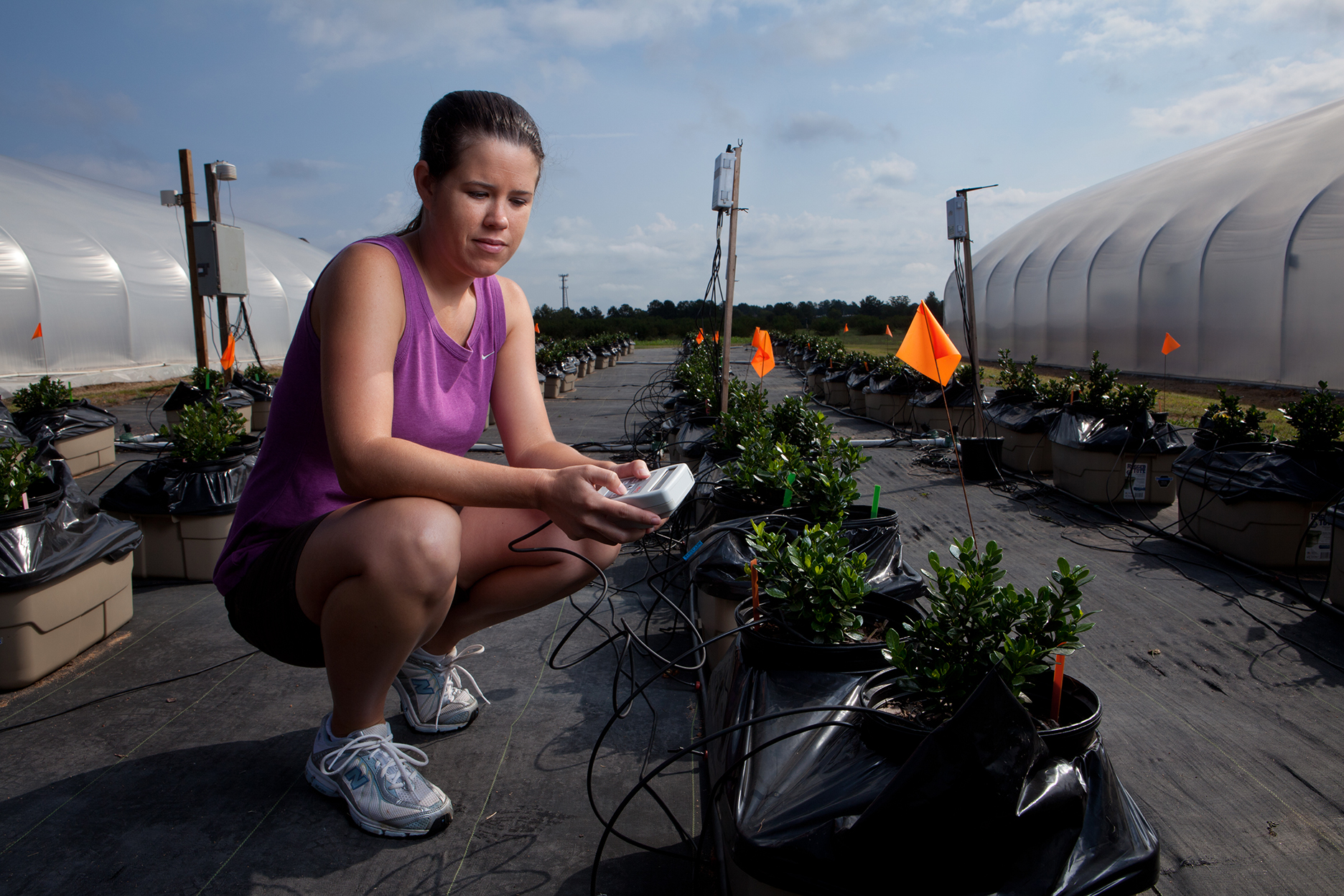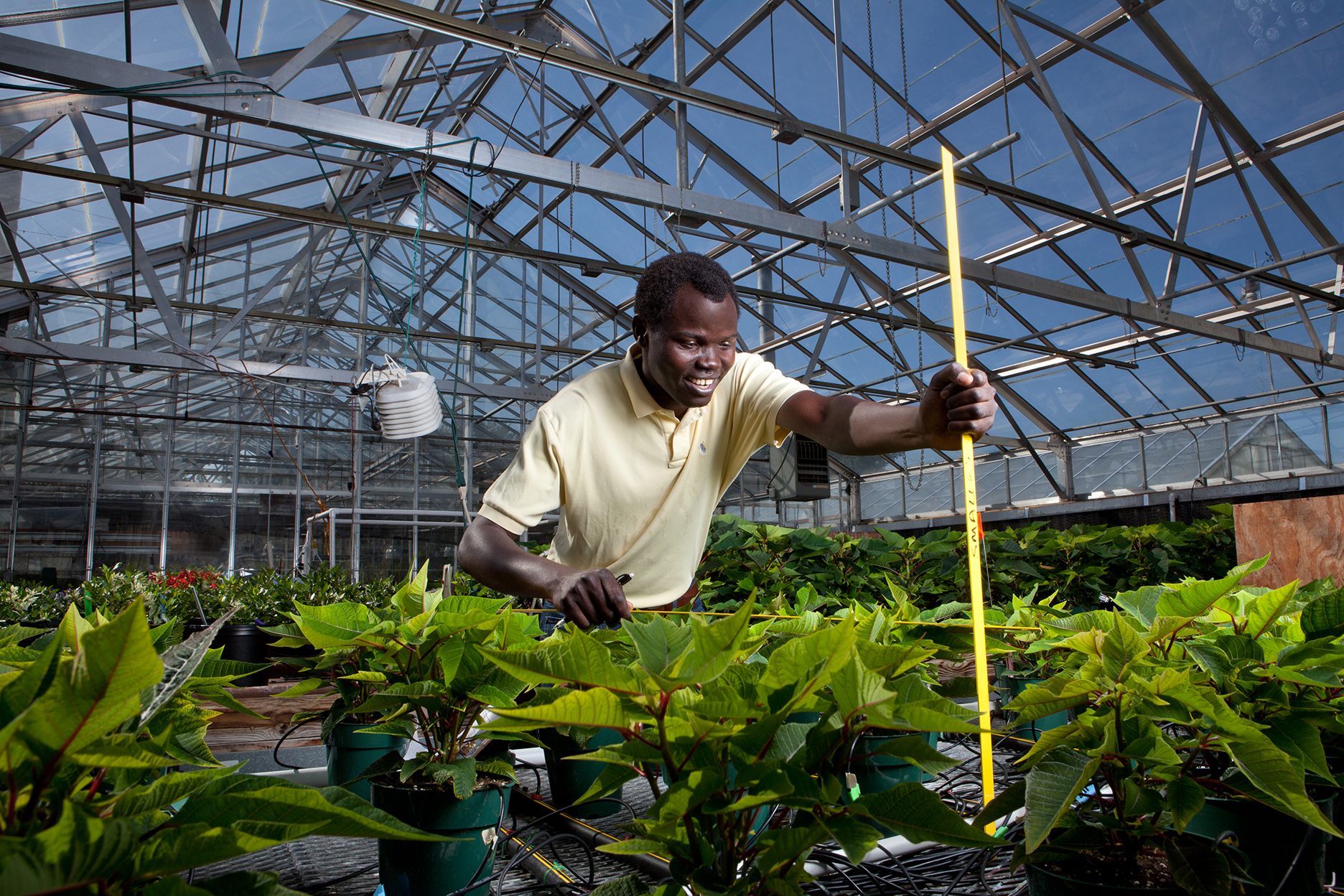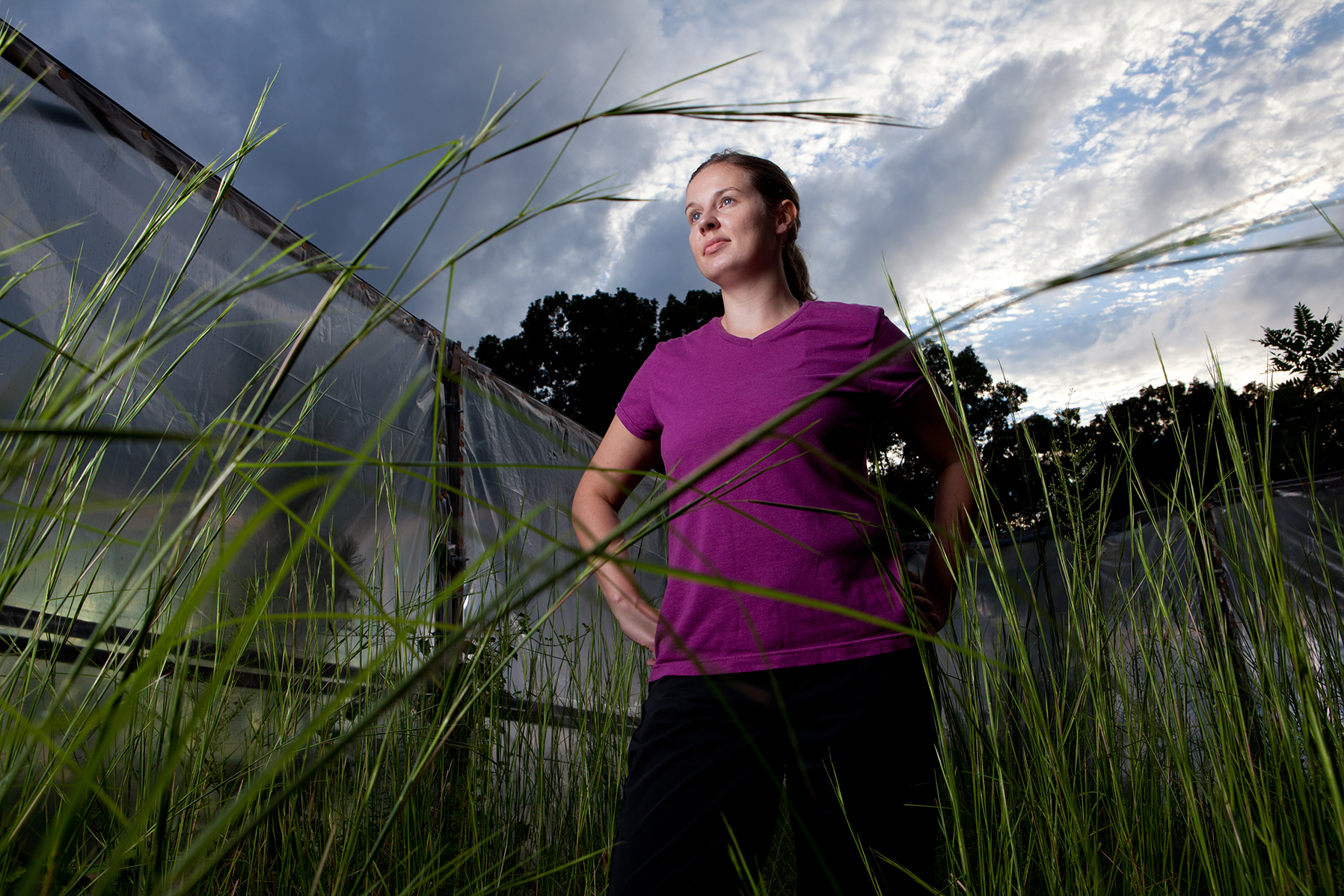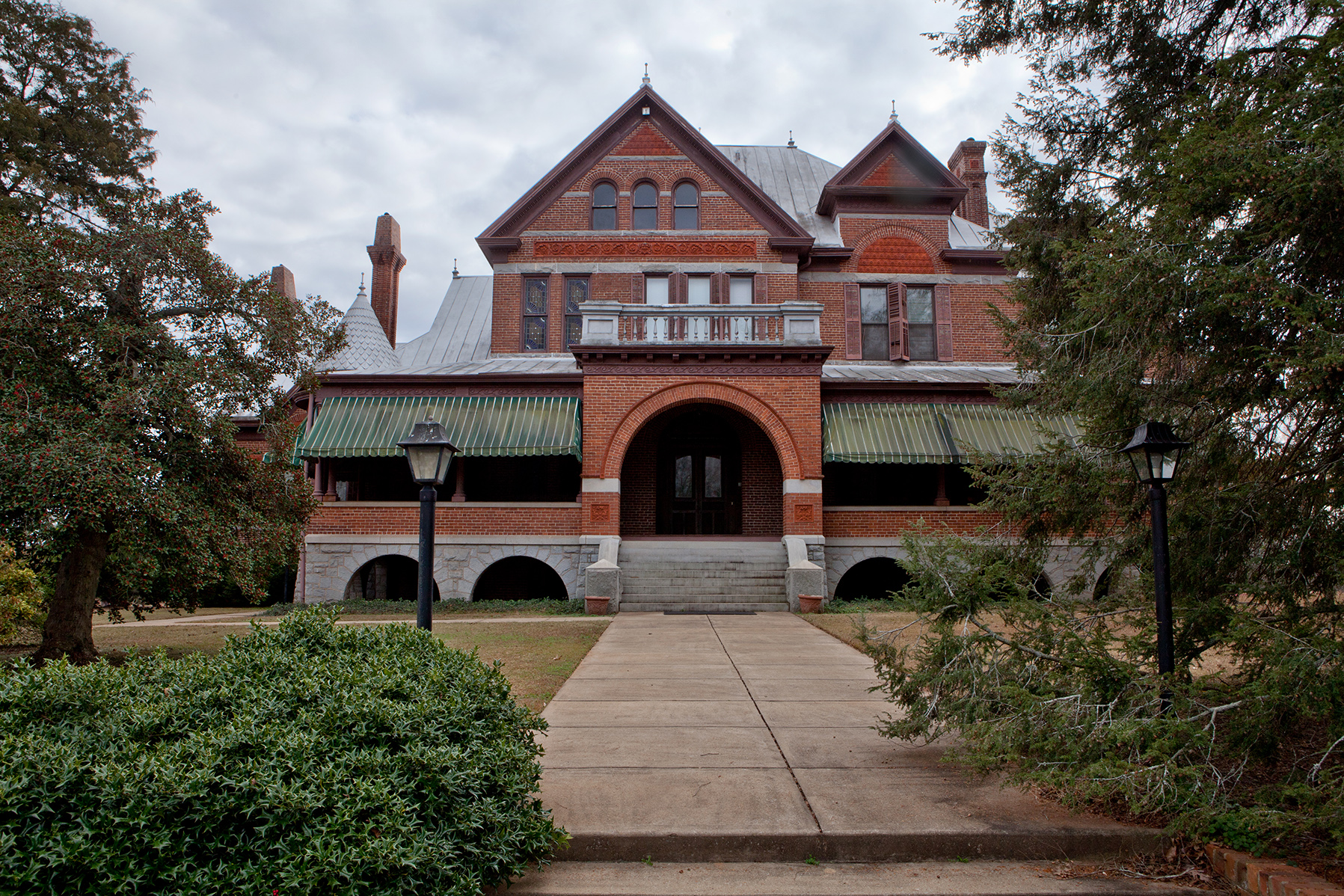Water Shortage, Drought and Climate Change Lead to Research Innovations
By: Cynthia Adams | Photos by: Nancy Evelyn
From Kansas to Kenya, Graduate Students’ Personal Histories Inform Water-Conserving Studies
Last summer, hay withered under a severe drought affecting 53 percent of the nation. Farmers were pleading online for hay. Some resorted to selling off their livestock. The USDA opened four million conservation acres for grazing. Ag Professional reported in 2012 that “U.S. taxpayers will pay a record $15 billion to subsidize the privately run crop insurance program this year, double the recent cost due to devastating drought in the Farm Belt.” In related developments, river levels from China to the Americas dropped. Interstate water wars over the Colorado, Missouri and Chattahoochee rivers continue in 2013.
Can UGA innovators change the game as water resources tighten and droughts become more extensive? University researchers tackle varied aspects of a water-challenged world.
Jacqueline Mohan is one of several University of Georgia ecological research professors whose climate-related ecological work has taken her to international research sites. Now Mohan is linking studies intended to reveal the effect of climate change on eastern forests at Whitehall Forest outside Athens, Ga., Harvard Forest in Massachusetts, and Duke Forest in Durham, N.C.
We know our seasons have grown hotter and drier. What isn’t known is precisely what that means for the future of our forests and plants. What species will survive? What will be lost? At Whitehall Forest outside Athens, Ga., researchers are at work on a long-term quest to find answers.
Mohan is one of several UGA ecological researchers whose work has taken her there and to research sites nationally and internationally, including the Coweeta Hydrologic Laboratory in Highlands, N.C. The Coweeta Station is set in naturally occurring upland forests and wetlands within the Appalachian Mountains. There, numerous researchers from several federal and state institutions, including UGA, study how nature responds to natural disturbances and atmospheric changes in both. While at the station, Mohan became colleague and friend to Chelcy Ford. (Ford’s work on a climate change committee in Washington, D.C., was profiled in this magazine last year.)
Much of Mohan’s research also concerns climate change, says Ford. “Either from the effects of CO2 increases or from temperature increases.” Towards that end, Mohan worked previously with a soil-warming experiment in New England at the Harvard Forest in Petersham, Mass.
Subsequently, she decided to implement a soil-warming experiment at Whitehall Forest.
Whitehall Forest is a research facility occupying nearly 850 acres. The land houses several offices and labs, including UGA and federal facilities. “One facet of Jackie’s work at Duke was on the FACE experiment (or Free-Air CO2 Enrichment Study),” says Ford. “She found that when CO2 concentrations increase in the forest, poison ivy (a noxious liana), increased both in size and toxicity in the oils that cause the rash it is so famous for. This is similar to the finding that pine trees exposed to higher CO2 concentrations have higher resin production.” Ford expresses the science simply, making it relatable.
“In other words, if the CO2 substrate concentration increases, but the tree or plant doesn’t really need it for growth or reproduction, or even if it does, defense compounds can increase,” explains Ford.
“In addition to finding that higher CO2 promoted more vigorous (and poisonous!) poison ivy,” Mohan says, “my research also shows that the juvenile trees that will likely make up the forests of the future will shift in composition.”
That shift, she finds, makes them among those “least able to absorb a lot of CO2 from the air.”
What will this mean?
“Slow growers,” Mohan finds, “like sugar maple and black cherry, do better. While important timber trees, like pine and tulip, don’t.”
Mohan and other researchers have various projects underway at Whitehall Forest, the Horticulture Farm at Watkinsville, Ga., and elsewhere. Some of those research projects are Specialty Crop Research Initiatives, known as SCRI. SCRI researchers include UGA professors Marc van Iersel and Harald Scherm. Van Iersel works with the physiology and nutrition of horticultural crops, focusing on carbon fixation of plant canopies. He also is the graduate coordinator in horticulture. An Assistant Dean of Research, Scherm is a professor of plant pathology.

Jackie Mohan with part of the climate warming research facility in background. Photo by Paul Efland / University of Georgia.
Rethinking Water Usage
It seems fitting that Kansan Amanda Bayer came to Georgia during a drought to undertake water conservation research.
After all, western Kansas once suffered mightily during an epic drought. The Midwest was the setting for the horrific Dust Bowl, the Depression-era phenomenon chronicled by John Steinbeck in The Grapes of Wrath. This was the worst environmental disaster in nearly 350 years.
The Great Plains were farmed to the point of disaster by homesteaders, who planted wheat and removed or overgrazed native prairie grass. Environmental damage in the Great Plains reached an apogee in the 1930s.
The lands literally blew away, in black storms that raged and killed. This was the tragic result of horrific, long-term drought, combined with poor farming practices. Inches of Great Plains dust landed on eastern cities as far as New York. The skies were blackened by swirling, wind-borne topsoil that, once lost, took decades to restore.
Steinbeck’s opus described the exodus of farmers fleeing in carloads. Their lands “dusted out” he wrote. Livestock starved or died of thirst. People died of dust-induced pneumonia. Farmers numbering nearly half a million left to search for new land or work. Woody Guthrie wrote haunting songs about that exodus. Thereafter, a 19-state region became known as the Dust Bowl.
The Midwest recovered with government incentives to change farm practices. But not until the 1950s did the worst of the impact resolve. The grinding drought eventually ended, but it required intervention to help change farming techniques. It is impossible to come of age as a Kansan and not hear the haunting story of the time when farmlands blew away.
Again, the Midwest and much of the nation suffered in the grips of the drought of 2012. It became desperately dry.
Even with cooling weather fronts by September 2012, the Farm Belt logged warmer-than-average temperatures based on data reaching to 1895. The vast majority of the continental United States, especially the lower Midwest, remained in moderate to severe drought. When the government began buying livestock from Midwestern farmers last year, it was eerily like the Dust Bowl years.
National Science Foundation Grant Links Interstate Project Sites
A project linking the University of Georgia, Harvard and Duke is titled “New Directions” on Jacqueline Mohan’s website. This project will help us better understand exactly how eastern forests might look in the coming century, says Mohan. She is a terrestrial ecosystem ecology and biogeochemistry professor in the Odum School of Ecology
In the spring of 2012, Mohan received a $554,000 grant from the National Science Foundation to study how forests are impacted by climate change. The award monies were to help develop more accurate predictions about those impacts.
“In general, climate models predict that the North will become wetter and the South drier, especially during the summer growing season—mirroring what we’ve been seeing over the last 15 years or so,” Mohan told ecology writer Beth Gavrilles. Over a five-year period, Mohan and fellow researchers at various sites will consider changes within native forest plots.
“We’ll be able to see which species are most responsive to those sorts of changes, in a positive or negative way.”
Professor Mohan’s project at Whitehall Forest, assisted by a number of UGA graduate students, will be compared to soil warming experiments undertaken elsewhere. Other sites include Harvard Forest in Massachusetts and Duke Forest in North Carolina, where James Clark leads the five-year effort. Participating researchers are also at the University of Illinois, Columbia University, Michigan State University, and the Smithsonian Tropical Research Institute.
The data mined will be used in building predictive models to better understand which species are under threat from climate change and which ones may thrive, says Mohan, in making future resource decisions.

Mandy Bayer at the UGA Horticulture Farm
1. My experiment is looking at the growth of Heaven Scent gardenia in response to different fertilizer levels (bag rate, 50%, and 25% of bag rate) and irrigation treatments. I collect leachate from the various containers and look at the electrical conductivity of the leachate which would differ due to the fertilizer level and irrigation volume. I am looking at shoot and root growth of the plants.
2. The box with the batteries that I connected the laptop to is a Decagon Devices EM50 dataogger that is reading GS3 sensors. The GS3 sensors measure substrate volumetric water content, electrical conductivity, and temperature.
3. For the light measurements I was using a Decagon Devices AccuPAR LP-80 ceptometer. This I used to measure photosynthetically active radiation (PAR). It uses the above canopy and below canopy measurements to calculate leaf area index (LAI), which tells me how light penetrates the canopy.
4. The soil moisture meter I was using was a ThetaProbe.
Amanda Bayer
Amanda (Mandy) Bayer grew up in Atchison, Kansas. She currently works in research with conservation and irrigation techniques, having previously worked in landscaping design. She will complete her doctoral studies in horticulture in 2014.
Bayer’s parents raised Christmas trees as a hobby.
“Growing up, my parents’ interest in plants showed me how many different aspects of growing plants there are—from growing a garden to landscaping. I realized then how beautiful and exciting plants can be.” After earning a bachelor’s degree in landscape contracting at Penn State in 2004, Bayer spent the following three years working as a landscape designer in Louisville, Ky. Those years working as a designer lent Bayer an understanding of the art of landscaping. Beauty had inherent rewards. Yet a deepening interest in the science side of the work compelled Bayer to earn a master’s at the University of Illinois.
Through her work with commercial nurseries and growers, Bayer became increasingly concerned with best practices and environmental matters. She and her husband, A. J., who also worked in landscape design, contemplated a move from Illinois to the University of Georgia just as “Georgia was coming out of a drought.”
Doctoral research at UGA made sense, Bayer says. “Georgia has a great reputation when it comes to drought related research.”
At the Horticulture Farm in Watkinsville, Ga., Bayer says her work with soil moisture sensors nears an end. UGA’s research with soil moisture sensors at the site has been underway since 2009. Bayer will soon have completed a total of four experiments since 2010. The experiments quantify exactly how much water is sufficient for optimal plant health.
“My advisor, Marc van Iersel, began work on the project the year before I got here as well, so UGA has completed three years’ worth of research, while I’m just beginning my third year here,” says Bayer.
With the aid of the sensors, the research team monitors soil moisture levels. The soil moisture sensors are about the size of a hand, or smaller, with 10 feet or more of attached cables. The soil moisture sensors are connected to a data logger, which is used to run a program controlling irrigation. “We use those to monitor the moisture of the substrate. When it drops below that (predetermined) level we irrigate.” Bayer is completing an experiment which has been ongoing for the past four months.
The change can produce striking water savings. Bayer offers a powerful example:
“Professor van Iersel estimates that one of the nurseries we are working with probably uses about 500 million gallons a year. Taking a conservative estimate—that they reduced irrigation by only 20 percent after seeing the benefits of reduced irrigation from our research—they would save about 100,000,000 gallons per year. The average household uses 350 gallons a day or 127,750 gallons per year. That means that just in this one nursery, we are saving enough water to supply about 800 households or about 2,000 people.” Of course, Bayer adds, this is an estimate.
Refined watering also improves plant health. “The focus has been how plant growth is affected by maintaining substrate water content. We are trying to show how to produce good quality plants while irrigating more efficiently,” Bayer says.
Bayer is completing the third of four experiments for the project, funded by the USDA through the Specialty Crops Research Initiative, or SCRI. Bayer’s professor, van Iersel, is among those associated with the SCRI research at various institutions. The SCRI has funded various research projects nationwide.
“My research is about more efficient irrigation for container nurseries,” explains Bayer. “These are nurseries that grow shrubs in pots that are then sold to garden centers.”
While keenly aware of issues related to irrigation practices, some commercial growers are habituated to over-watering. No more over-watering by growers translates into less waste, leaching, and disease.
There is a practical incentive beyond water conservation, Bayer notes.
“Even for growers it might not be the straight water-savings that matters to them. Disease incidence and insects can be helped by monitoring.”
Bayer points out an additional problem of over-fertilizing container plants, which causes leaching from the pots into the environment. “Some people have to be aware of this—you don’t need the leaching—so fertilizer salts don’t build up in the substrate.”
The soil moisture sensors, Bayer believes, can help nurseries deal with the obvious restrictions of the future, and comply with inevitable laws and regulations. (Bayer mentions the states around the Chesapeake Bay, which have tight restrictions concerning runoff.)
“I hope our work helps people deal with that.”
Over Watered and Over Fertilized: Changing the Southern Landscape
A beautiful landscape is intrinsically rewarding, Bayer agrees. But in relation to drought, Bayer says there is a growing reality check.
“The realization is that, as the water crisis develops, with the population increasing, water available to nursery crops and ornamentals is the first area that would be restricted quite closely. “
Bayer believes nurseries will not be as negatively impacted as they could be in the future. The sensor could prove to lessen the impact of water restrictions.
“The nurseries we have worked with have been happy with the [moisture-detecting] systems,” she says. Bayer’s current plan is to continue pursuits in plant physiology and efficient irrigation. Through working with her major professors, horticulturalists van Iersel and John Ruter, Bayer says she has come to enjoy the teaching side of academia. She is currently a teaching assistant, helping with the identification of woody plants. In addition to earning her doctorate, Bayer hopes to obtain the Interdisciplinary Certificate in University Teaching through the UGA Graduate School.

Alem O. Peter at Horticulture Greenhouses measuring poinsettia plants in experiment.
Peter O. Alem
Before Isak Dinesen romanticized the beauty of Kenya, thrilling readers, and before her contemporary, Hemingway, depicted it as a manly proving ground, a romanticized Rubicon—there was always the Kenya that has suffered much. Drought and water shortages are the subtext of sub-Saharan Africa.
Peter O. Alem’s home country, Kenya, suffers one of the most severe water shortages on Earth. In the mid-1970s, its government instituted a National Water Master Plan, intended to provide drinkable water within walking distance of all Kenyan people.
That goal remains unmet.
As you read this, Alem will almost certainly be thinking about water, if not in the context of his UGA doctoral research. On the 300-mile ride along rough roads from Nairobi to his home village, Gem, he passes changing terrain. River beds grow drier; streams disappear. Kenyans must walk further than ever in search of drinkable water.
For three weeks in January, this doctoral student who has taken his surname as his first, escorted friends made in South Carolina to Kenya. Alem says he took them to Gem in hopes of encouraging educational sponsorship of village children, and to drill some water wells. Rather than live a life of struggle, others, too, may become a researcher or educator, or water conservationist, just as he has done. Perhaps a few fortunate village women will get water closer to their homes.
Schooling, and kindly sponsors, changed Alem’s life. Education, too, is nearly as vital for survival as water. His brother, Samson Llimbe Alem, who works for the Kenyan branch of the Centers for Disease Control, is also a scientist.
For now, Alem is reminiscing on this birthday about how he would have celebrated back home. When he is not thinking about water-related research, he thinks of Kenya with a touch of longing. There is hardship but also great community in Gem.
Sometimes lush, sometimes standing in stark relief against the African sky, Kenya is home to African buffalos, big cats, wildebeest and rhino. There is a confluence of thrumming life competing for water. There is the savannah and the bush, with thin trails of water and muddy pans after a rain. But always, there is the quest for enough water.
“Back in Kenya, I did work at the National Environmental Management Authority under a lead environmental expert,” he says. “Water is a very important issue and that’s how I became interested in this.” Alem has been working on his doctoral research since arriving at UGA August 10, 2010, which was only three days after he finished his master’s at Clemson University.
Prior to college studies, Alem had never left his village, though he could speak English by the sixth grade. (English was his third language. Luo is his native tongue. Alem’s second language is Swahili, the national language.)
With the ease of a young Harry Belafonte, Alem laughs, breaking his reverie. Travel, as the adage says, has broadened him. “I think I’m better, more tolerant and adaptable.” He speaks to tolerance and how valuable it is. “UGA offers a big international environment and there is so much to do,” he says earnestly. The water shortages in Kenya are dealt with in stark contrast to extended drought periods in the American Southeast. For example, in Gem, Alem says, there are almost no stretches of grassy lawns, no matter how rich the homeowner.
“We only probably water the grass on the soccer fields,” he explains. There is a strict prioritization of consumption, which is a matter of survival. “We will have to have water for many urgent needs,” he says, tenting his fingers.
Alem grew up with people porting water for long distances for those urgent needs. “People walking miles to get water,” he says. Walks to port water grow longer as water grows scarcer. “If people think about changing times,” Alem recalls, “they recall when there were little rivers and streams that are no longer there.”
Water is a defining issue in places around the globe. But in Africa, it is especially crucial.
When Alem returns to Kenya, he quickly re-adapts to life there, bathing with a small pail of water. “I would not take a shower,” he says. “The water used to take a shower for one person (here in the States) is probably the amount of water used for a few people back in Kenya.” And as one of six siblings, he is accustomed to sharing.
He marvels at the relative ease of life in the United States. You open a tap and water appears. You jump into a car and arrive straightaway—no potholes, no dirt roads. American conveniences, the innovation and abundance, are good and enjoyable. But the simplicity of Kenyan life is also beautiful.
Alem’s home village is 300 miles from Nairobi, but the roads were so poor the drive to Nairobi was an ordeal. “It takes about eight hours. When I go from UGA to Clemson, I can be at Clemson in one hour, without fear I am going to hit a big pothole!”
He began his graduate education at Clemson University, with plans to study environmental horticulture and become an educator. “I was considering a doctorate,” he remembers, “but in a different school to broaden my experience in working with people.”
Plus, there was the dominant concern of water. He recalls the drying streams and riverbeds back home. “Water is such an issue in Africa,” he stresses. When Alem learned of his acceptance at UGA, he grabbed the opportunity to expand his studies, combining water and plant nutrition management.
For the past two years, Alem’s doctoral research with major professor Marc van Iersel has concerned creating more effi cient irrigation systems in greenhouse production. Soil moisture sensors measure real-time soil moisture content and trigger irrigation when it is most necessary. He explains the irrigation systems they have researched. “When the soil is dry enough that the plants need more water, the irrigation begins; otherwise, systems used static times, a clock system. A clock system is not effi cient. It will automatically water, regardless,” Alem explains.
“When the soil is dry enough, and plants need water, irrigation is turned on; otherwise, nothing happens.” The crucial difference, Alem explains, is an intelligent system.
“Conventional irrigation systems use static timers, a clock system that triggers irrigation based on a pre-determined time schedule, regardless of the soil moisture content. The clock system is not efficient, and may result in a lot of water wastage.” In places around the globe, already hard pressed for water, waste is unacceptable.
Alem can also export his knowledge for the benefit of African growers. “In Kenya, they grow a lot of roses in greenhouses. Water management is very critical. In the greenhouse, people water and fertilize their plants artificially. The excess of both winds up with water waste and nutrients getting into the water system and causing environmental problems. Any person in agriculture who is thinking of working in this area must be concerned with this.”
He knows that present research can save water and fertilizer and improve grower outcomes as well. “The specific question I am addressing is: ‘If we do irrigate and fertilize plants efficiently, can we save water and/or fertilizer and can we reduce water and fertilizer requirements for plant production in the greenhouses?'”
Despite missing family and traditions of Africa, Alem says he loves UGA and the chance to participate in work that will make life better for so many. “I’m having an amazing time in Graduate School.”

Melanie Kay Taylor at Whitehall Forest experiment site for testing soil warming.
The chambers are heated to either +3 or +5 degrees C. The types of seedlings and their growth is measured and compared with control chambers that are not being heated.
The instrument is a LiCor 6400XT. The Mohan lab uses it to measure photosynthetic rates and soil respiration.
Melanie Taylor
Melanie Taylor is Mohan’s graduate student. She came of age in the mountains of Bluefield, Va., where droughts are less commonplace. Yet, the mountains were in plain view, and Taylor was attuned to changes.
“I grew up in southwestern Virginia where coal-mining is a predominant industry. Man’s impact on land was apparent to me, even as a child,” she says.
She was observant, and liked school. Taylor especially liked biology and science. There was one singular teacher who filled her with intrigue concerning the world and possibilities beyond Bluefield.
“Mr. Winters taught at Graham High school. He left a mark on a lot of people,” she says with a smile. Winters posed difficult environmental questions.
What are we doing and what are we leaving behind?” he asked students. Taylor describes how Winters awakened his students to science and the world, while “teaching us, discussing a lot of environmental things.”
Big dreams can take root in small places. Taylor dreamed of becoming an educator, like Winters, or a scientist, after high school. But her family could scarcely afford that.
The way to that dream, Taylor decided, was to enlist in the military. A recruiter assured her she would be able to attend college free on the G. I. Bill after fulfilling her term of service. Taylor hadn’t imagined herself standing in a recruiter’s office, enlisting in the Navy. Yet here she was, doing exactly that, at age 18. Taylor was uprooted, far from the hills of Bluefield.
Before receiving an assignment, she submitted to a battery of aptitude tests. Taylor scored especially well in math and science. She wound up being given a choice between training for work on a submarine as a nuclear engineer and working on land with naval aeronautics.
Again, Taylor couldn’t imagine herself in that scenario, being confined for months on end in a submarine. She chose aeronautic work.
She completed her training, becoming a Petty Officer, 2nd Class. “I was in the Navy for five years,” Taylor says. She still has her dress uniform but laughs that she might not fit into it, though she remains slim.
“I worked on P-3 Orions—a surveillance plane,” Taylor says, and wound up being posted around the United States and in the Middle East. The discipline and rigors of the military shaped her. The work was difficult and structured. And it was dangerous. On Taylor’s final deployment to Iraq, she supervised a work center of individuals repairing electronic equipment. The base where Taylor worked endured regular mortar attacks. One such day made Taylor a hero.
Mohan says her graduate student, “actually came under mortar fire while she was leading a group of soldiers in electrical repair in the field. She got all her men back safely to shelter, and kept the instrument from falling into enemy hands. Needless to say, she is cool under pressure and her electrical training with the Navy has prepared her to be a ‘natural’ when it comes to figuring out and repairing the many electrical technologies we use in our research.”
It also netted Taylor special recognition, Mohan adds,“ for leadership and bravery.”
Taylor received the Iraq Campaign Medal, the Global War on Terrorism Medal, and the Good Conduct Medal. The honor that counted most to Taylor was the Navy and Marine Corps Achievement Medal.
She was still in her twenties. Taylor was encouraged to remain in the Navy, but chose to leave. There was that scientist dream that had been incubating for many years now.
Having always longed for a life of scholarship, she exchanged the stresses of military life for Graduate School. “I eventually want to do a PhD,” Taylor says, adding that military life has taught her necessary self-discipline. This semester, she is a teaching assistant in ecology handling three lab sections and loving it. “This week, we are catching butterflies,” she smiles.
A UGA ecology professor, James Porter, teaches the lecture portion of the class Taylor assists with in the lab. He has rekindled all the fi res once stoked by the Virginia high school teacher.
“Jim Porter is a wonderful lecturer. He makes students feel like they could walk out the door and change the world. We need more of that.” Now, Taylor has a new goal. She aspires to become a professor
About six miles outside Athens, Taylor stands by one of the research plots at Whitehall. Whitehall is a peaceful place. It is apart from the bustle of the UGA campus; these former farmlands are now heavily wooded.
There is a canopy of trees, yet, this summer morning the woods almost heave with heat—the natural sort, that doesn’t come from a buried cable. Summer temperatures throughout the South have been intense and rain scarce. The soil is dry, and scatters with the scuff of a shoe.
“Whitehall is where most of my thesis data will come from,” Taylor says quietly. “What we’re doing here is really significant. What kind of forest are our grand kids going to be experiencing? What kind of experience will our grand kids have?”
Taylor enters a small building where computer equipment monitors the temperature variations.
“Tick-tick-tick” the equipment ticks, as it transfers data from a data collection area at Whitehall. Taylor often works with the technical equipment, work which harkens back to her Naval days. She chats about climate change projections of three-five degree Celsius, and microbial DNA tests.
Taylor likes talking science.
The researchers monitor the effect on seedlings that have been deliberately planted there. “Others have been naturally recruited,” explains Taylor.
The researchers take careful inventory and study soil cores. They watch, measure, and crunch endless amounts of data.
Above the rising morning sun, which radiates uncomfortable, steamy heat, there is a blur of wing: A hawk passes. Mosquitoes hum around ankles, eager to feed upon sweaty arms and legs. The researchers recently dealt with an infestation of caterpillars that munched the leaves off the trees in the research area. Taylor and companions scan warily for poison ivy, one plant that is proven to thrive in a hotter, drier climate, according to Monahan’s research.
Mother Nature, perhaps a little hot and bothered herself, knows precisely how to keep things interesting when the heat is turned up.
After all, it is her forest. Dynamic, throbbing, closely watched, it watches back.

Whitehall Mansion on an overcast day








